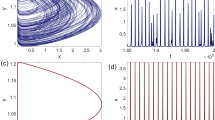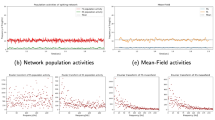Abstract.
A system of coupled bistable Hopf oscillators with an external periodic input source was used to model the ability of interacting neural populations to synchronize and desynchronize in response to variations of the input signal. We propose that, in biological systems, the settings of internal and external coupling strengths will affect the behaviour of the system to a greater degree than the input frequency. While input frequency and coupling strength were varied, the spatio-temporal dynamics of the network was examined by the bi-orthogonal decomposition technique. Within this method, effects of variation of input frequency and coupling strength were analyzed in terms of global, spatial and temporal mode entropy and energy, using the spatio-temporal data of the system. We observed a discontinuous evolution of spatio-temporal patterns depending sensitively on both the input frequency and the internal and external coupling strengths of the network.
Similar content being viewed by others
Author information
Authors and Affiliations
Additional information
Received: 10 June 1998 / Accepted in revised form: 9 August 1999
Rights and permissions
About this article
Cite this article
Schwarz, J., Sieck, A., Dangelmayr, G. et al. Mode dynamics of interacting neural populations by bi-orthogonal spectral decomposition. Biol Cybern 82, 231–245 (2000). https://doi.org/10.1007/s004220050023
Issue Date:
DOI: https://doi.org/10.1007/s004220050023




